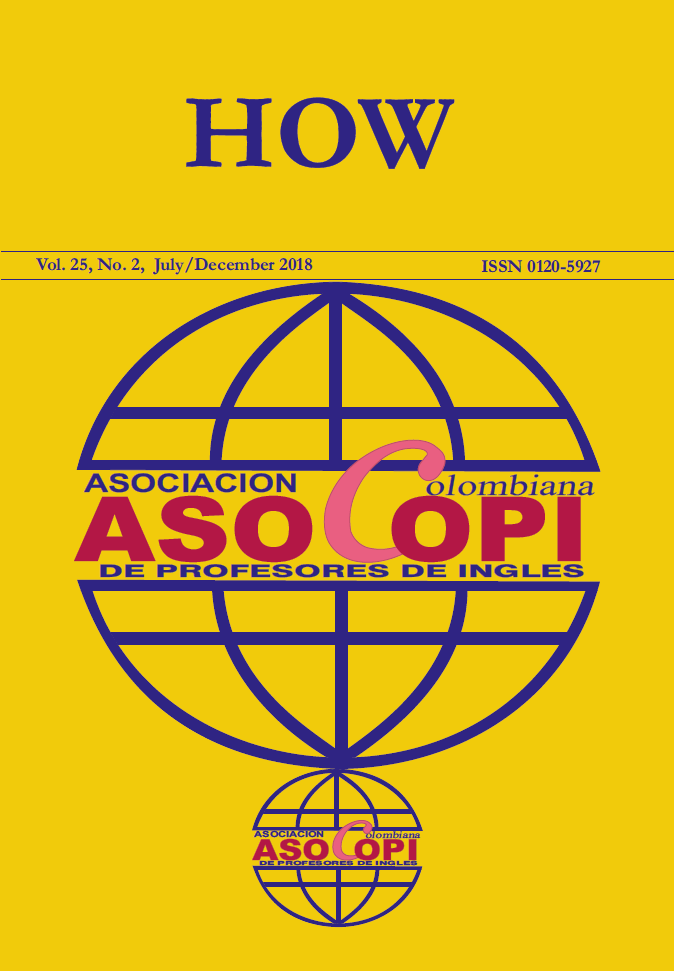El papel del idioma en la identidad de maestros de inglés transnacionales
Contenido principal del artículo
Resumen
Detalles del artículo
Los contenidos de la revista HOW se publican bajo la licencia Creative Commons Atribución-NoComercial-SinDerivar 4.0 Internacional. Usted es libre para copiar y redistribuir el material en cualquier medio o formato siempre y cuando usted otorgue el crédito de manera apropiada. Usted no puede hacer uso del material con fines comerciales. Si usted mezcla, transforma o crea nuevo material a partir de esta obra, usted no podrá distribuir el material modificado. Más información: http://creativecommons.org/licenses/by-nc-nd/4.0/deed.es.
Se solicitará a los autores cuyos artículos se aceptan para publicación en HOW que firmen una cesión de derechos no exclusiva con el fin de permitir a ASOCOPI reproducir el texto completo en el internet o en cualquier otro medio disponible. Los autores conservan los derechos sobre sus manuscritos con las siguientes restricciones: el derecho de primera publicación es otorgado a ASOCOPI; los autores pueden establecer acuerdos no exclusivos con terceros siempre y cuando la publicación original en la revista HOW sea reconocida adecuadamente.
Citas
Bernal, M. E., & Knight, G. P. (Eds.). (1993). Ethnic identity: Formation and transmission among Hispanics and other minorities. Albany, US: State University of New York Press.
Berry, J. W. (1990). Psychology of acculturation. In J. J. Berman (Ed.), Nebraska Symposium on Motivation: Cross-cultural perspectives (pp. 201-234). Lincoln, US: University of Nebraska Press.
Bierman, K. L., Domitrovich, C. E., Nix, R. L., Gest, S. D., Welsh, J. A., Greenberg, M. T., & Gill, S. (2008). Promoting academic and social‐emotional school readiness: The Head Start REDI program. Child Development, 79(6), 1802-1817. https://doi.org/10.1111/j.1467-8624.2008.01227.x.
Boroianu, S. F. (2008). “She called me a Mexican!”: A study of ethnic identity (Doctoral dissertation). University of Northern Iowa, USA.
Bucholtz, M., & Hall, K. (2004). Language and identity. In A. Duranti (Ed.), A companion to linguistic anthropology (pp. 368-394). Malden, US: Blackwell Publishing.
Buckingham, D. (2008). Introducing identity. In D. Buckingham (Ed.), Youth, identity, and digital media (pp. 1-24). Cambridge, US: The MIT Press.
Cornejo Espejo, J. (2012). Educación, interculturalidad y ciudadanía [Education, interculturality, and citzenship]. Educar em Revista, Curitibia, Brasil, 43, 239-254. https://doi.org/10.1590/S0104-40602012000100016.
Creswell, J. W. (2012). Qualitative inquiry and research design: Choosing among five approaches. London, UK: Sage.
Dervin, F. (2008). Métamorphoses identitaires en situation de mobilité. Turku, FI: Humanoria.
Dervin, F., & Gao, G. (2012) Constructing a fairy tale around intercultural couplehood on Chinese television. Language and Intercultural Communication, 12(1), 6-23. https://doi.org/10.1080/14708477.2011.630471.
Devos, T. (2006). Implicit bicultural identity among Mexican American and Asian American college students. Cultural Diversity and Ethnic Minority Psychology, 12(3), 381-402. https://doi.org/10.1037/1099-9809.12.3.381.
Falicov, C. J. (2007). Working with transnational immigrants: Expanding meanings of family, community, and culture. Family Process, 46(2), 157-171. https://doi.org/10.1111/j.1545-5300.2007.00201.x.
Hatch, J. A., & Wisniewski, R. (Eds.). (2002). Life history and narrative. Washington, D.C.: Routledge.
Holliday, A. (2010). Intercultural communication and ideology. London, UK: Sage.
Holmes, J. (1992). An introduction to sociolinguistics. New York, US: Routledge.
LaBarbera, M. C. (2015). Identity and migration: An introduction. In M. C. LaBarbera (Ed.), International perspectives on migration (pp. 1-13). Berlin, DE: Springer International Publishing.
Mirdal, G. M., & Ryynänen-Karjalainen, L. (2004). Migration and transcultural identities. Strasbourg, FR: European Science Foundation.
Moll, L. C., Amanti, C., Neff, D., & Gonzalez, N. (1992). Funds of knowledge for teaching: Using a qualitative approach to connect homes and classrooms. Theory Into Practice, 31(2), 132-141. https://doi.org/10.1080/00405849209543534.
Padilla, A. M. (1994). Bicultural development: A theoretical and empirical examination. In R. G. Malgady & O. Rodriguez (Eds.), Theoretical and conceptual issues in Hispanic mental health (pp. 20-51). Melbourne, US: Robert E Krieger Publishing.
Phinney, J. S., Romero, I., Nava, M., & Huang, D. (2001). The role of language, parents, and peers in ethnic identity among adolescents in immigrant families. Journal of Youth and Adolescence, 30(2),135-153. https://doi.org/10.1023/A:1010389607319.
Piller, I. (2011). Intercultural communication. Edinburgh, UK: Edinburgh University Press.
Riccio, B. (2001). From “ethnic group” to “transnational community”? Senegalese migrants’ ambivalent experiences and multiple trajectories. Journal of Ethnic and Migration Studies, 27(4),583-599. https://doi.org/10.1080/13691830120090395.
Schiller, N. G., Basch, L., & Blanc‐Szanton, C. (1992). Transnationalism: A new analytic framework for understanding migration. Annals of the New York Academy of Sciences, 645, 1-24. https://doi.org/10.1111/j.1749-6632.1992.tb33484.x.
Smith, M. P. (1994). Can you imagine? Transnational migration and the globalization of grassroots politics. Social Text, 4(39), 15-33. https://doi.org/10.2307/466362.
Super, C., & Harkness, S. (1997). The cultural structuring of child development. In J. W. Berry, P. R. Dasen, & T. S. Saraswathi (Eds.), Handbook of cross-cultural psychology: Basic processes and human Development (Vol. 2, pp. 1-39). Boston, US: Allyn & Bacon.
Tinley, A. (2006). Migración de Guanajuato a Alabama: experiencias escolares de cuatro familias mexicanas. Sociológica, 21(60), 143-172.
Vertovec, S. (2001). Transnationalism and identity. Journal of Ethnic and Migration Studies, 27(4), 573-582. https://doi.org/10.1080/13691830120090386.
Zuñiga, V. (2000). Migrantes internacionales de México a Estados Unidos: hacia la creación de políticas educativas binacionales. In R. Tuirán K. (Ed.), Migración México-Estados Unidos: opciones de política (pp. 300-327). México: CONAPO.
Zúñiga, V., & Hamann, E. T. (2009). Sojourners in Mexico with US school experience: A new taxonomy for transnational students. Comparative Education Review, 53(3), 329-353. https://doi.org/10.1086/599356.
Xu, J., Shim, S., Lotz, S., & Almeida, D. (2004). Ethnic identity, socialization factors, and culture‐specific consumption behavior. Psychology & Marketing, 21(2), 93-112. https://doi.org/10.1002/mar.10117.





